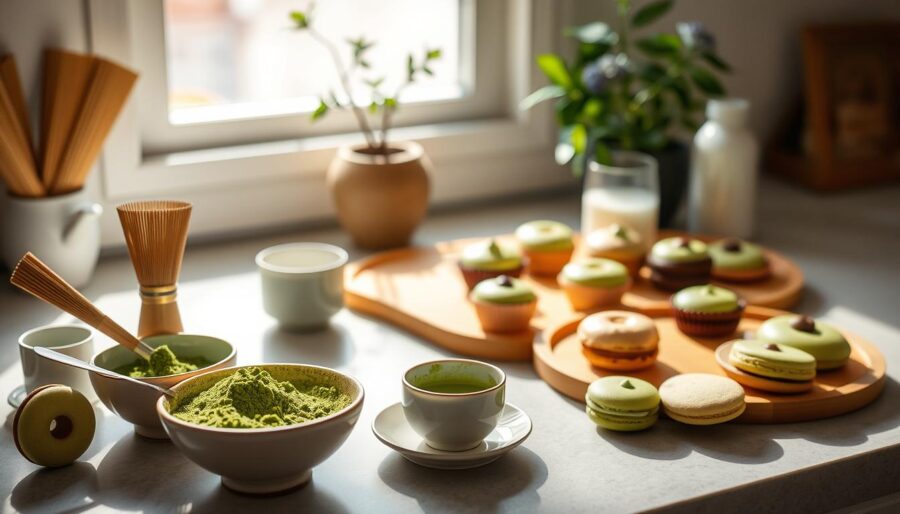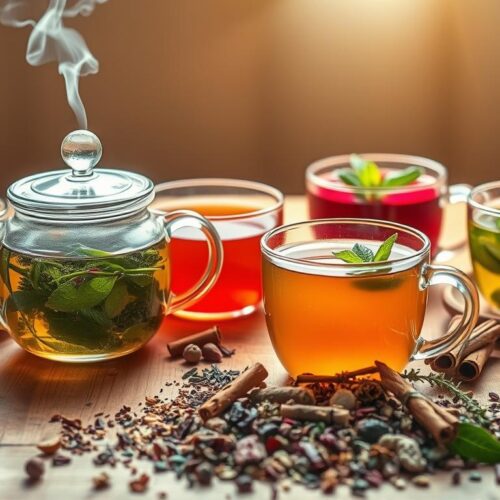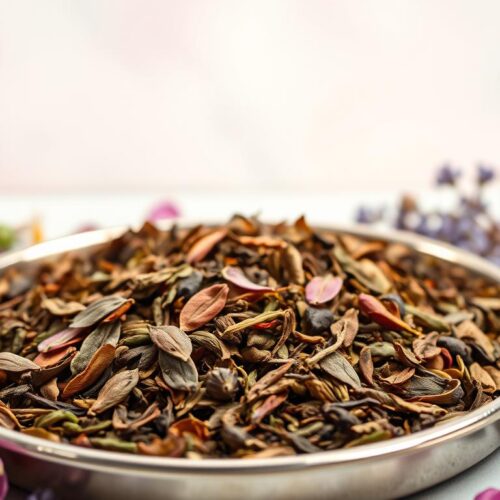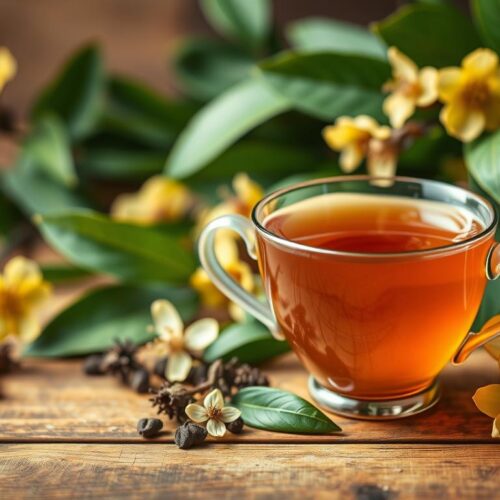You’ve seen the vibrant green latte, right? Well, matcha is more than a passing fad. This japanese tea starts as tencha leaves, grown in the shade. They are carefully picked and ground into fine matcha powder. When you whisk it and drink, you consume the entire leaf.
This is why many believe in matcha’s health perks.
In this guide, we dive into how matcha is made in Uji, Shizuoka, and Kagoshima. These places turn soft leaves into the bright, fragrant tea we love. We’ll discuss how the term ceremonial grade matcha might be misleading in the U.S. We will explain how its true quality lies in its flavor, color, and texture.
Let’s follow matcha’s journey from Zen temples to your morning mug. We will compare its caffeine content to coffee’s. Plus, we’ll cover the tools you need to make it at home. You’ll learn how to prepare it quickly, store it properly, and enhance its flavor.
What is Matcha?
Matcha is a special form of Japanese tea made from leaves grown in the shade. To increase chlorophyll and amino acids, farmers cover the plants for 25 to 30 days before picking them. After steaming and drying into tencha, the leaves are then ground into fine matcha powder. This powder is mixed with water to drink, letting you enjoy the full leaf.
Tea as a fine powder started in China during the Song Dynasty. However, it was in Japan where the technique flourished, influenced by Zen practices in tea ceremonies. The art of making matcha today still involves traditional methods, like grinding with granite stone mills. These methods help give matcha its vibrant green color and rich umami taste.
While both matcha and green tea come from the same plant, they offer different experiences. Unlike green tea that infuses water with flavor, matcha gives you the whole leaf. This makes its texture and health benefits unique compared to regular green tea.
Ceremonial and culinary grades of matcha differ significantly. Ceremonial grade is made from the first harvest and is ideal for drinking plain. Culinary grade is stronger and works great in recipes. Aged tencha is ground slowly to keep its fresh taste and smell.
Not all green tea powders qualify as matcha. Some are not grown in Japan or are processed too quickly, losing quality. To find real matcha, check where and how it was made. This ensures you’re getting the authentic flavor and benefits of traditional Japanese matcha.
Nutritional Profile of Matcha
Drinking matcha means you’re consuming the whole leaf. This gives you more caffeine, L-theanine, and antioxidants than in regular tea. The entire leaf contributes to matcha’s unique benefits that you experience as you sip.
L-theanine and caffeine work together to make you feel calm and focused. This energy feels smooth, not sharp. The tea’s deep green hue and fresh taste come from chlorophyll, thanks to shade-growing.
EGCG is a key antioxidant in matcha, joined by many polyphenols. They’re known to fight free radicals and reduce oxidative stress. You’ll also find some vitamin E, which is great for your skin and brain.
Remember, the health benefits of matcha vary. They depend on how and when it’s harvested and prepared. The way you make your matcha, including water temperature and freshness, affects its nutrients.
Matcha has more caffeine than other japanese teas because you drink the actual leaf. This often leads to a gentle alertness without the downsides, thanks to the L-theanine.
| Component | What It Is | Why It Matters | Influenced By |
|---|---|---|---|
| Caffeine | Natural stimulant in matcha powder | Supports alertness and focus | Leaf grade, serving size, water temperature |
| L-theanine | Amino acid linked to umami | Promotes relaxed attention when paired with caffeine | Shade-growing, harvest timing |
| EGCG | Key catechin antioxidant | Helps combat free radicals and inflammation | Freshness, storage, preparation |
| Polyphenols | Broad antioxidant group in japanese tea | Supports defenses against oxidative stress | Processing, water temperature |
| Chlorophyll | Green plant pigment | Signals shade-grown leaves and rich phytonutrients | Shade duration, leaf quality |
| Vitamin E | Fat-soluble vitamin | Supports skin and cognitive health | Leaf freshness, storage |
Choosing high-grade matcha from respected Japanese makers, like Ippodo or Ito En, ensures the best flavor and benefits. A fresh, sweet-smelling powder usually means it’s nutrient-rich and will taste smoother.
For daily drinking, sift your powder, watch your water temperature, and whisk well. These steps ensure your matcha tastes great and keeps its vibrant quality.
Top Matcha Benefits You Should Know
Matcha gives you a calm and steady energy boost. This is due to caffeine and L-theanine, which help prevent the jitters or crashes from coffee.
Whisking the whole leaf means matcha has more caffeine and theanine. This boosts alertness for work or study. But remember, the serving size and quality matter.
Antioxidants are a big part of what makes matcha great. EGCG and other polyphenols fight free radicals and support health. You’ll feel it most when matcha is part of a healthy diet.
Matcha is different from green tea because you consume the whole leaf. This packs more flavor and nutrients into each sip. That’s why even a little can be very effective.
Ceremonial grade matcha is best for daily drinking. It tastes cleaner and mixes into a consistent foam. This makes your drink smoother and naturally sweet without extra sugar.
Many enjoy matcha for its focus and mood benefits. L-theanine keeps you calm yet alert. It’s great before tasks that need concentration.
EGCG in matcha might boost your metabolism when paired with exercise and good sleep. But be wary of exaggerated claims.
Matcha is good for heart health and overall wellness when consumed mindfully. Pay attention to how your body reacts and adapt accordingly.
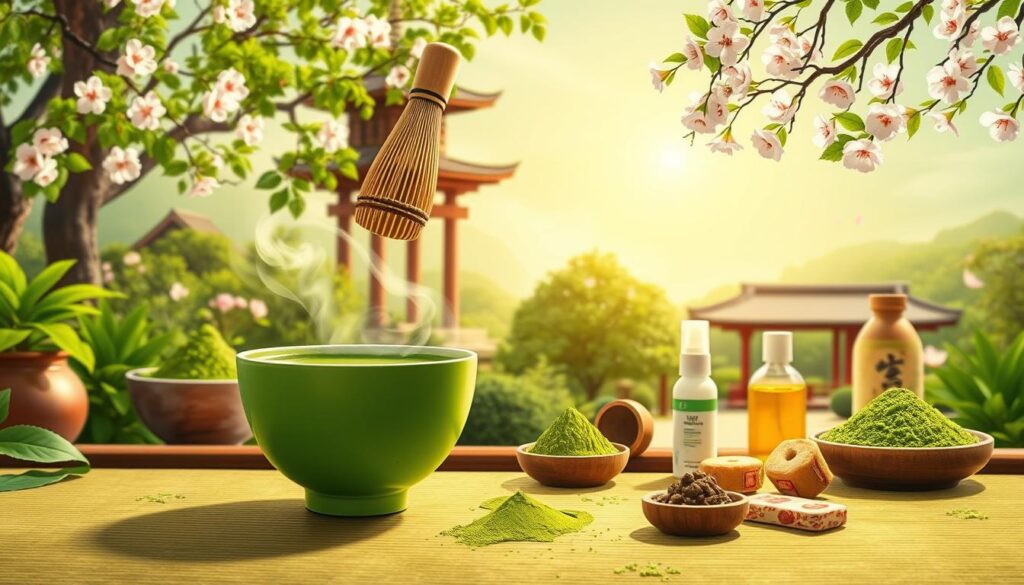
How to Prepare Matcha
Mastering matcha at home is easy with the right tools and fresh matcha powder. Start by preheating a chawan (bowl), then drying it. Next, sift about 2 grams of matcha into the bowl. Pour in 3 ounces of water heated to around 190°F. Whisk quickly in a zigzag motion for 20 seconds using a chasen (whisk). This method, called usucha, creates a bright, foamy cup of Japanese tea.
For a thicker matcha, koicha, use 6–8 grams of matcha. Only add 1.5 ounces of 190°F water. Slowly knead with the chasen until it becomes glossy. Only add more water as needed. Koicha highlights the matcha’s deep flavors, perfect for ceremonial grades.
Making iced matcha is quick. Sift 3 grams of matcha over 4–5 ice cubes in a bottle. Then add 8 ounces of cold filtered water. Shake it all for 15 seconds and strain into a glass. Enjoy a refreshing twist on Japanese tea.
Like lattes? Start with 3–3.5 grams of matcha. Bloom it with 80 grams of warm water at about 115°F. Dissolve by whisking, then create foam with zigzag whisks for a minute. Pour it over ice and add around 100 grams of milk. Sweeten with honey, maple, vanilla, or a pinch of salt to taste.
Stick to simple, authentic tools: chawan, chasen, chashaku (scoop), sifter, and a tea towel. A digital scale is handy for precise doses. A whisk holder maintains the chasen’s shape. Sifting is key to avoid clumps and grit in your matcha.
Store your matcha properly to preserve its flavor. Seal the tins well and keep them cool and dark. Choose high-quality, stone-ground tea for the best experience. A chasen is better than balloons or cheap frothers for achieving the perfect texture and foam.
| Style | Matcha Dose | Water/Milk | Temp | Technique | Texture/Result |
|---|---|---|---|---|---|
| Usucha (thin) | ~2 g (about 1 tsp) | 3 oz water | ~190°F | Whisk fast in zigzags ~20 sec | Fine foam, clean and bright japanese tea |
| Koicha (thick) | 6–8 g | 1.5 oz water | ~190°F | Knead slowly to glossy paste | Dense, syrupy body; no bubbles |
| Iced Matcha | ~3 g | 8 oz cold water + ice | Cold | Shake ~15 sec; strain | Crisp, refreshing, low bitterness |
| Matcha Latte | 3–3.5 g | 80 g warm water + ~100 g milk | ~115°F bloom | Whisk to dissolve, then whip 1 min | Creamy, balanced, cafe‑style cup |
| Simple Single‑Serve | ~1/2 tsp | 2–3 oz hot water | Hot, not boiling | W/M whisk ~20 sec | Quick, foamy everyday matcha |
| Key Tools | Chashaku (1 g per scoop) | Chawan | — | Chasen, sifter, scale | Smoother body; fewer clumps in matcha powder |
These methods let you make matcha to suit your taste and time. Try different styles to experience matcha’s full range. Go from a quiet bowl of tea to a quick, energizing iced drink.
Matcha and Your Health
With matcha, you’re drinking the entire leaf. This means you get more antioxidants, caffeine, and L-theanine compared to brewed Japanese tea. The result is steady focus, less jitteriness, and a smooth boost that many find lasts longer.
Looking at matcha versus green tea, both have good stuff like EGCG, vitamin E, and compounds that fight off harm from free radicals. People say eating foods high in these antioxidants is good for your heart and energy. But remember, most of these findings come from studies that just observe, not prove cause and effect.
People often say matcha is good for your heart and helps manage your weight. Things in matcha, like EGCG, are known to help your metabolism. And L-theanine with caffeine can keep you sharp without a sudden tired feeling. But, the effects can change depending on the matcha’s quality, how much you take, and your diet.
Since matcha is a concentrated kind of Japanese tea, you get a bigger dose of healthy stuff in each cup. But, remember to watch your caffeine intake, especially if you’re sensitive to it or pregnant. If you take medications or have health issues, talk with a doctor before changing how much matcha you drink.
| Aspect | Matcha | Brewed Green Tea | What It Means for You |
|---|---|---|---|
| Antioxidants (EGCG) | Higher per serving due to whole-leaf intake | Lower per serving as an infusion | Greater exposure may support antioxidant defenses |
| Caffeine + L-theanine | More caffeine with notable L-theanine | Less caffeine and theanine | Often described as calm, steady energy |
| Heart Health Discussion | Frequently linked to supportive roles | Also linked, but at lighter potency | Associations exist; outcomes depend on lifestyle |
| Weight Management Talk | Catechins often cited for metabolic support | Similar, at lower levels | Potential aid when paired with diet and activity |
| Bioavailability | Varies by grade and preparation | Varies by steep time and water temp | Quality and method influence matcha benefits |
You can use matcha instead of a sweet drink or an extra cup of coffee. This change might help you reduce added sugar while enjoying a nice energy boost. Watch how your body reacts and adjust the amount you drink as needed.
If you care about taste, choose ceremonial grade for drinking and culinary grade for cooking or in smoothies. This small decision can make matcha more enjoyable. It also helps you keep using matcha over time.
Matcha in the Kitchen
You can easily add the strong flavor of matcha to your everyday cooking. Use culinary-grade matcha, like Karasu and Wakatake, for cooking. It works well with milk, sugar, and heat. Drink ceremonial matcha or better grades plain. Use the culinary grade for lattes, smoothies, and baking. This ensures you get the full benefits of matcha without losing its special taste.
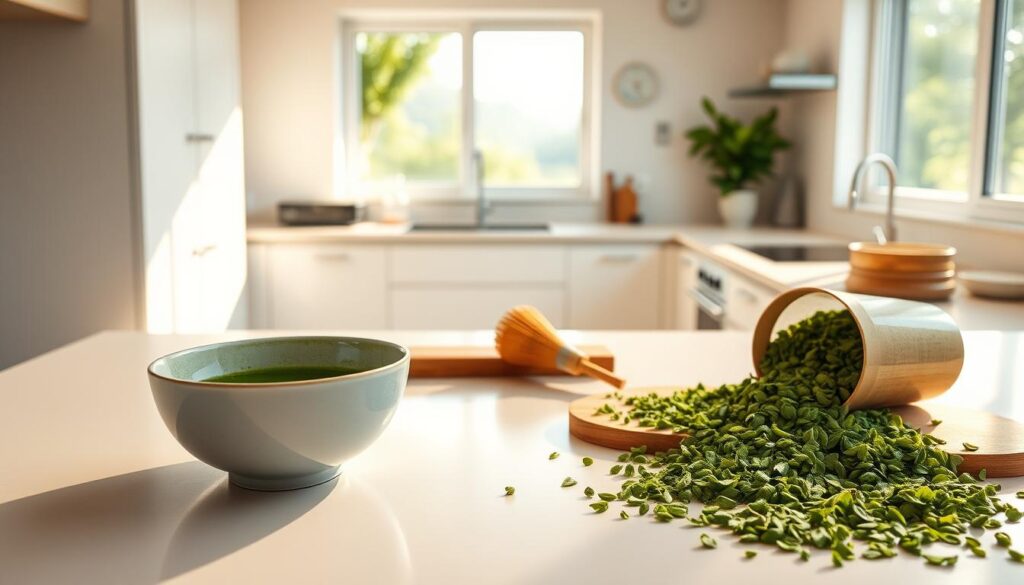
For cookies and cakes, use 1–4 tablespoons of matcha powder. This depends on how strong you want the flavor and color. Reduce the flour by the same amount to get the texture right. For ice cream and frozen treats, also use 1–4 tablespoons. Matcha thickens the mix and pairs well with flavors like ginger, honey, and vanilla.
To add a twist to savory dishes, make matcha salt. Mix 1 part matcha with 4 parts coarse sea salt. Sprinkle it on grilled salmon, roasted veggies, or fries. This mix boosts the umami flavor and adds a fresh, green touch that honors the origins of Japanese tea.
Cafés often choose culinary grade matcha for lattes. To make an iced latte, whisk 4 grams of matcha with a pinch of salt, 10 grams of honey, a dash of vanilla, and 60 grams of cold water until it’s smooth. Then, add ice and 200 grams of cold milk of your choice. The flavor gets better as the ice melts, balancing the sweetness and matcha’s sharp taste.
Matcha is great in cocktails, especially shaken ones. Combine Avuá Prata Cachaça, Mizu Shochu, fresh lime juice, simple syrup, 1 gram of matcha, and an egg white. First, shake without ice. Then, shake with ice. Strain it and lightly sprinkle matcha powder on top for a smooth, fragrant foam.
- Smoothies: mix spinach, banana, yogurt, and 2 teaspoons matcha for a refreshing energy boost and sweetness.
- Muffins: mix in 1–2 tablespoons; white chocolate or yuzu zest enhance the matcha’s benefits and scent.
- Lattes for beginners: warm milk with honey and vanilla or lavender reduces the bitterness while keeping matcha’s unique flavor.
| Use | Grade | Ratio/Tip | Flavor Outcome |
|---|---|---|---|
| Lattes (hot/iced) | Culinary | 3–4 g per 8–10 oz milk; honey + vanilla | Bold, creamy, balanced sweetness |
| Baking (cookies, cakes) | Culinary | 1–4 tbsp; reduce flour equally | Vivid color, bittersweet depth |
| Frozen desserts | Culinary | 1–4 tbsp; natural thickening | Dense, velvety texture |
| Finishing salt | Culinary | 1:4 matcha to sea salt | Clean, savory lift |
| Sipping straight | Ceremonial or higher | 2 g whisked with 60–70 ml water | Smooth, delicate, sweet-green |
Buy your culinary matcha from places like Shizuoka to ensure good quality. Keep it sealed from air, heat, and light, and use it within a few months. Making smart choices and following simple guidelines lets you make matcha a key ingredient in your cooking. It gives you constant flavor and real matcha benefits.
Best Brands and Where to Buy Matcha
For the best matcha, it must come from Japan and mention its region. Make sure “stone-ground” is on the label, and it looks bright green. The top ceremonial grade matcha feels soft like cornstarch. It smells strongly of pine and sweet cream. If it smells weak, it will probably taste weak too.
Only buy from sellers who tell you where and how it’s made. Good cafés and roasters will have fresh Japanese tea and keep their stock updated. Store your matcha in a cool, dark spot. Keep it sealed to keep out light and air.
In Pursuit of Tea offers Choan and Unkaku, great for a thick tea because of their deep sweetness. They have almost no bitter taste. Kiji and Wako are good for a lighter tea every day. Karasu and Wakatake are perfect for cold matcha and lattes.
Ippodo Tea in Kyoto has Ummon for a rich taste and Sayaka for a smooth, sweet drink that goes well with milk. Breakaway Matcha is known for its vivid color and fresh taste in cold drinks. Matchaful gives good quality without high prices.
Café owners often pick culinary grades from Shizuoka for top-notch lattes. It’s best to buy in small amounts and use them up quickly. After you open your Japanese tea, keep it cold if you can, and seal it tight again.
- Buy: Japanese origin, stone-ground, disclosed harvest and region.
- Assess: vivid green, fine texture, layered aroma of nuts, chocolate, and cream.
- Taste: dense body with balanced bitterness, sweetness, and umami.
- Store: cool, dark, airtight to protect matcha powder from light and air.
| Brand/Source | Notable Picks | Best Use | Key Traits |
|---|---|---|---|
| In Pursuit of Tea | Choan, Unkaku | Koicha and special whisked bowls | Ultra-fine grind, profound sweetness, virtually no astringency |
| In Pursuit of Tea | Kiji, Wako | Daily usucha | Creamy body, fresh green flavor, slight bittersweetness |
| In Pursuit of Tea | Karasu, Wakatake | Lattes, baking, iced matcha | Culinary grade, sturdy flavor for milk and recipes |
| Ippodo Tea (Kyoto) | Ummon, Sayaka | Straight bowls and daily lattes | Deep umami or smooth, light sweetness with subtle bitterness |
| Breakaway Matcha | Cold-brew selections | Chilled whisked drinks | High color and clarity of flavor, fine particle size |
| Matchaful | Single-origin options | Budget-friendly daily bowls | Good quality-to-price ratio, reliable freshness |
When unsure, start with small sizes, try them out, and trust your taste. Properly chosen, your ceremonial grade matcha will taste sweetly complex. It will have a clean taste and a bright green finish.
Incorporating Matcha into Your Daily Routine
Start your morning calmly with usucha. Sift 2 grams of matcha into a warm chawan. Add water near 190°F. Then whisk with a chasen in a fast zigzag until creamy foam appears. This way, you make matcha that tastes bright and smooth. On special days, go for koicha with high-quality matcha like Ippodo Choan or Marukyu Koyamaen Unkaku for a thicker, sweeter cup.
When it’s hot out, shake matcha over ice. Just add sifted matcha and cold water to a bottle, and shake well for 20 seconds. This cools the drink, cuts the bitterness, and makes it sweeter. It’s fast, easy to carry, and perfect for busy mornings.
Keep your matcha fresh. Sealed tins last a long time before opening. Once opened, keep in the fridge and use within six months to keep its flavor and color vibrant. This keeps the quality high and helps you make great matcha every time.
For a daily latte, use 3 to 3.5 grams of matcha. Bloom it with water around 115°F and whisk until it’s glossy. Then, pour over ice. Add milk, a little honey, vanilla, and a pinch of salt. Home tastes better with ceremonial grade matcha for a clean flavor. If matcha is a daily drink, consider 100-gram pouches like Ippodo Sayaka for value.
Need a boost in the afternoon? Matcha gives a steady focus. It has less caffeine than coffee, between 30–70 mg. Try an iced matcha latte with honey or vanilla. Add lavender for an extra touch. Just use a wide mug, sifter, and a whisk or frother. As the ice melts, it softens the flavor for lasting enjoyment.
Choosing between matcha and green tea? Consider your daily routine and tools. Matcha is a fine powder that lets you drink the leaf itself. It offers you the full benefits directly. Green tea is steeped and strained. For everyday, matcha suits both quiet times and active ones, while green tea is good for a quick cup anywhere.
Conclusion: Why You Should Try Matcha Today
Matcha is unique, blending ancient Japanese traditions with your fast-paced life. You can enjoy it hot, cold, or even in food. Drinking it means you get the whole leaf. This gives you caffeine and L-theanine for a calm, focused energy. Unlike coffee, it won’t make you crash.
What you buy really matters. Choose matcha from Japan, which looks bright green and smells sweet. Keep it in the fridge, well-sealed, and sift it for better flavor. Brands like Ippodo (Ummon, Sayaka), Breakaway Matcha, and Matchaful are trustworthy. They offer great taste and quality without you having to worry.
Be realistic about health claims. Matcha is packed with antioxidants and vitamins that support health. But it’s not a miracle cure. What it does offer is mental clarity, satisfaction, and a pause in your day. With different grades for drinking and cooking, there’s an option for every budget.
To start, sift matcha, mix with warm water, and whisk till it’s frothy. Then, try making lattes, cool spritzers, or even cocktails. Using real Japanese tea and preparing it right brings out its best. You’ll enjoy great taste and lasting focus. This is what makes matcha benefits stand out. It’s a great addition to your routine or a special weekend joy.

